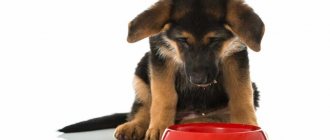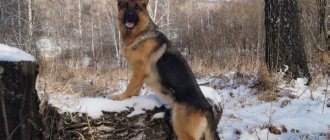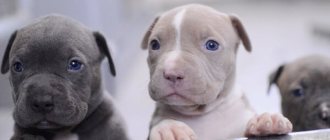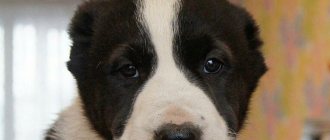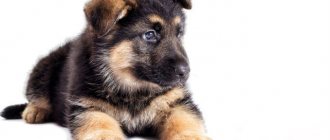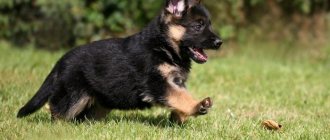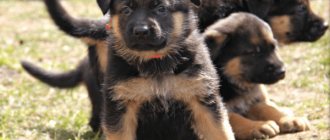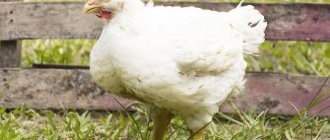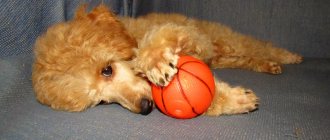Review author: “ZooVita”
The German Shepherd is a dog breed that is very popular all over the world. She lives next to a person for many years and not only gives him her love, but also helps him in every possible way. This breed has a special friendliness and a sharp mind, so it is often adopted as a family friend and used as a service dog for work in the army, police and the Ministry of Emergency Situations.
What does it look like?
Newborn
Puppies in the first month of life all look the same. They have a pointed, elongated muzzle, with a large black nose.
Each puppy has short, shiny fur. Each of them weighs from 350-500 grams. The more puppies are born, the less the weight of each of them.
Description by month
When the baby turns one month old, characteristic differences appear:
- Size : from 18 – 21 cm.
- Body : The back is short and the chest is wide.
- Paws : against the background of the body they look very large, there is also no dewclaw.
- Weight : ranges from 3 to 4.5 kg.
- Eye color : dark brown, but in rare cases the color can remain blue for up to two months.
- Ears: soft and large, can hang up to 6 months.
- Teeth : There is a scissor bite on the front teeth.
- Coat : hard, thick undercoat has appeared.
When puppies reach 2 months of age, their paws and tail grow very much. Bones are formed in 28-30 days, but by the second month they are still very fragile.
The puppy becomes stronger in build by the 4th month, and the joint bumps are also very prominent.
If compared with a newborn puppy, by 6-7 months the size increases 7-8 times. The head becomes very large. At the age of 6 months, growth stops and muscle mass increases.
From 9 to 12 months, the young shepherd will rapidly gain weight. The muscles actively develop and the bone skeleton is finally strengthened. Growth stops, if it subsequently increases, it will be no more than 2-3 cm.
Photo
Below you can see photos of puppies aged 1, 2, 3 and 4 months, including black ones.
Safety precautions
If a shepherd puppy grows up in a city apartment, a number of rules must be followed to protect it from injury. There are almost no differences here from other puppies or even small children:
- Wires should be hidden in special boxes or plinths.
- Strengthen or remove unstable furniture.
- Don't let him play with small, fragile toys: he will definitely break them and swallow the fragments.
- Anything that lies within his reach will be stolen and turned into a toy, so things must be put away in cabinets and drawers.
- To prevent the puppy from sharpening its teeth on all surrounding objects, it must have its own training equipment. They are sold in abundance in veterinary pharmacies - these are bones from ox veins, and scraps of rope, and cast heavy balls. You need to bring home 2-3 toys, and he will choose his favorite one.
- There should be a carpet or other similar covering on a slippery floor: the puppy’s weak paws are easily injured on a slippery floor.
- If there are children in the house, they need to be instructed how to properly handle the dog. The main thing is not to allow him to be picked up: even at three months he is quite heavy, up to 10 kg, and his paws are weak, they can easily be injured if he is accidentally dropped.
Features of dog development at 1 year
This age is a very responsible one for a shepherd. The dog is going through the transition from being a teenager to being an adult dog. In appearance, this is a completely adult dog, but it will mature until it is 2 years old. The last parameter of maturation is the formation of the central nervous system.
Guard and defensive instincts are also formed. There may be attempts to prove their leadership among other dogs, which often ends in fights. Training will help get rid of unnecessary aggression.
What to feed?
- Cereals cooked in water: rice, buckwheat, less often oats and barley, peas and pearl barley - exclude.;
- It is better to give fresh meat from 600 to 800 grams per day;
- Dry food.
Large dogs do not have new teeth, so bones should not be given. You can purchase a special bone. It is forbidden to feed the animal food from your table!
Table of development and weight up to one year
| Age (month) | Height (cm) | Male weight (kg) | Female weight (kg) | Chest circumference (cm) |
| 1 | 19-22 | 3,3-4 | 3-3,4 | 28-32 |
| 2 | 32-40 | 8,5-9 | 7-8 | 45-50 |
| 3 | 40-47 | 14-15 | 11,5-12,5 | 55-59 |
| 4 | 48-57 | 19-20 | 16-16,5 | 60-65 |
| 5 | 50-58 | 22-23 | 20-22 | 65-70 |
| 6 | 52-60 | 24-26 | 22,5-23 | 69-72 |
| 7 | 53-62 | 28-28,4 | 23-24,8 | 70-72 |
| 8 | 53-62 | 28-30 | 25-25,3 | 73-74 |
| 9 | 53-62 | 30,5-32 | 27-27,5 | 74-75 |
| 10 | 54-63 | 32,2-32,9 | 28-29,5 | 75-77 |
| 11 | 54-63 | 33-33,5 | 28-29,5 | 75-77 |
| 12 | 55-64 | 33-35 | 30-32 | 75-77 |
Nicknames
For boy
Modern names for boys:
- Alex.
- Apollo.
- Atlas.
- Boris.
- Brunson.
- Bruno.
- Captain.
- Cain.
- Duke.
- Dino.
- Ernie.
- Fletch.
- Fido.
- Freddie.
- Goliath.
- Hercules.
- Harley.
- Larry.
- Maximus.
- Rex.
- Newton.
- Lobster.
- Owen.
- Omega.
- Polo.
- Rudy.
For girl
Popular nicknames for girls:
- Angel.
- Alian.
- Aba.
- Abigail.
- Annabelle.
- Athena.
- Alexandra.
- Anna.
- Ava.
- Blair.
- Boni.
- Chloe.
- Cassie.
- Cleopatra.
- Erika.
- Elsa.
- Venus.
- Gloria.
- Hayley
- Isabel.
- Lucy.
- Milli.
- Mia.
- Maxi.
- Rose.
- Rachel.
When do teeth change?
The replacement of baby teeth begins in shepherd dogs between 12-14 weeks. Itching in the oral cavity is possible; to reduce it, you can give the puppy rubber toys or large bones. This will also help get rid of already loose baby teeth.
Attention! Some dogs experience fever and lethargy when they change teeth. If you notice that your pet is feeling unwell, then reduce walks and active games. Protect from stressful situations.
If you notice that a baby tooth is very loose, you can remove it yourself. When removing, pull the tooth upward to prevent damage. Firmly seated teeth should not be removed, as fragments may remain in the gums.
The change of canines occurs at the age of 4 months. At the age of 10 months, all of the dog’s teeth are molars.
Vaccination schedule
The table below shows the vaccination schedule for puppies by age, which veterinarians recommend following:
| Age | Graft | Revaccination | Using the example of the drug used |
| 8-10 weeks | from enteritis, from plague, from parainfluenza, from infectious hepatitis, from adeno- and parvovirosis, from leptospirosis | after 21-28 days |
|
| 12-13 weeks | from rabies | not being done |
|
When vaccinating, you should adhere to the following basic rules:
- 10-14 days before the procedure it is necessary to carry out deworming;
- You cannot vaccinate a puppy under 2 months old, a pregnant or lactating female;
- it is important to use the same drug for vaccination and revaccination;
- the puppy must be absolutely healthy.
All vaccinations must be repeated annually.
Slight lethargy and decreased activity of the puppy after vaccination is a normal reaction of the body.
Also, the first vaccination should not be given to the puppy before 8 weeks - not only is such vaccination considered “zero” among veterinarians (the puppy’s body simply will not develop immunity from diseases), but it can also significantly undermine the baby’s health.
What time do your ears stand up?
Ears begin to stand up between 1.5 months and 5 months. Over time, the cartilage strengthens and the ears become larger. The change of teeth is directly related to the formation of the ears, so they can stand up at 2 months, and fall again by 3 months.
Observe the ears carefully from 5 to 6 months; if they are not erect by the age of six months, contact your veterinarian. After 7 months it is very difficult to place ears.
Why isn't this happening?
There are a number of reasons why German Shepherds' ears don't stand up:
- Not purebred shepherd. People are often deceived and sold non-purebred puppies. Such animals often have problems with the formation of ears. When purchasing, carefully check all documents for the dog.
- Insufficient amount of minerals. With poor nutrition and lack of essential substances, cartilage may not form properly.
- Ear diseases. Any inflammation can negatively affect the performance.
- Irregular fit or structure of the ears. Let's say the ears are very large and large or, on the contrary, thin. In this case, in order not to harm the animal, seek help from a veterinarian.
- Weak immunity and frequent illnesses. If your pet is often sick, he may not have enough nutrients to form cartilage.
How to install?
If your pet is more than 4 months old, and the ears are not set and are quite flaccid, you need to take action.
- Massage the ears. Massage stimulates blood circulation, which will have a positive effect when performing.
- Sound. Unusual and unexpected sounds will attract the puppy's attention, and he will turn around and raise his ears fully for a while. Thanks to such training, the muscle tissue of the auricle will be strengthened and over time it will completely move to a vertical position.
- Balanced diet. If the dog lacks nutrients, then cartilage will not develop. The menu must include: fish, dairy products.
- Introduce fertilizers with sufficient amounts of microelements.
- Glue the ears. You will need foam rollers without plastic inserts and a patch. Try to choose a curler based on the size of your ear, as too large or small will bring less benefit. Insert the foam rubber into the auricle without covering the ear canal, secure with adhesive tape. Do not use tape - it can injure the puppy's skin. The structure must be removed after seven days. If there are no changes, repeat the procedure.
Important! If, after taking measures, the ears still do not stand up by 6 months, contact your veterinarian.
Nutrition for German Shepherd dogs
The German Shepherd eats both natural food and commercial food, the main thing is that the diet is balanced. From birth, you need to make sure that the puppy receives amino acids and proteins in its food, otherwise its health will not be strong, and the puppy itself will grow up weak.
The diet of a German Shepherd must include such foods as: lean meat; buckwheat, wheat and rice porridge; vegetables; milk; dairy products; berries.
You should also carefully monitor the amount of food you eat, as an excess of it will have a bad effect on your dog’s health. It is strictly contraindicated to feed raw fish, exotic fruits and leftovers from the common table, because this can lead to gastrointestinal upset.
How to care for your pet?
- To keep your pet healthy, regular hygiene is necessary. Ears are cleaned once every two weeks.
To do this, apply a special product to a cotton pad and gently clean the ear. If the color of the discharge is yellow, it means everything is in order. But if the discharge is dark in color, contains pus, or has an unpleasant, pungent odor, contact your veterinarian. - You need to brush your shepherd twice a week. If the molting period has arrived - every day.
- Pay attention to your eyes. Dogs of this breed are not prone to eye diseases, but if you notice purulent discharge, redness or swelling, contact a specialist immediately.
- At the age of 2 months, begin to accustom your shepherd to cutting his nails. Lay the animal on its side or sit it down. Fix the chosen position and remove 2-3 mm of the nail with a special tool. Be careful not to touch the blood vessels. If you get it and start bleeding, treat the nail with peroxide.
- During the year, the dog is taken for vaccinations three times.
- At 1 month of age, begin introducing complementary foods. This can be either dry specialized food, soaked in water, or chopped, lean meat (rabbit, turkey). Kefir and cottage cheese are also allowed. Upon reaching 1.5 months, introduce porridge (rice and oatmeal). The meat can be cut into small pieces.
By the 3rd month it is necessary to introduce vegetables. First boiled, and after some time - raw.Number of meals:
- up to 2 months – 6 times;
from 2-3 months – 5 times;
- from 3-6 months – 3 times;
- from 6 months – 2 times.
Walking mode
For full development, the puppy should walk outside more. Of course, only after all vaccinations. When he is small, he can be taken out 5-6 times a day for 15-20 minutes. He must get used to going outside to relieve himself, so it is necessary to walk him immediately after sleep, after eating, and before bed. The older he gets, the longer the walks should be. The walk should be combined with games and training. After a year, the German Shepherd can be given for special training - capture, training in the “face” command. This is not necessary in order to turn him into a bodyguard; the shepherd will already protect his owner in a critical situation. This is necessary so that she gets used to discipline and unquestioning submission. After all, a large dog that cannot be controlled is a very dangerous phenomenon.
Walks should ultimately be at least 1 hour in the morning and 2 hours in the evening. In order for the dog to be socially active and not afraid of city noises, you should take it on short trips, guests, and give the puppy the opportunity to run around with peers.
Training a puppy begins from 1 month of his life: the earlier he starts to exercise, the more flexible his brain will become and the deeper his intellect. The first command for a puppy is his name. Then he can be taught commands: place, fu, sit, lie down, voice, next to him. These and several other similar commands make it easier to control the puppy and are called a general training course (GTC). He can take a special training course at a canine club or training school after a year.
Due to the ideal balance of strength and intelligence, the German Shepherd has become an indispensable assistant and partner for a person in almost all areas of his activity. She can be an excellent shepherd or guard. Millions of dogs of this breed serve in the military, police and other law enforcement agencies. They are sappers, trackers, and customs officers.
Who is better: a boy or a girl?
Before making a new friend, you need to decide on the gender. For a novice dog breeder, it is best to buy a girl. Females are more docile and easy to train. Males, on the contrary, show a character that will need to be pacified. But in turn, boys are more active, stately and somewhat larger in size.
The choice may be influenced by the purpose of purchasing this particular breed.
- If you are purchasing an animal for yourself and are encountering this breed for the first time, then it is better to take a girl. She becomes attached to her owner faster than a boy and is much easier to raise.
- For participation in exhibitions and possible breeding, a boy is best suited. If he has a good pedigree, then he will be of interest to breeders.
- For security or work, a boy is also better suited.
Origin story
The history of the origin of the German Shepherd as a separate breed began more than 100 years ago . Initially, these were large dogs with a developed protective instinct and a heightened sense of smell, so hunters used them as assistants.
But the main purpose of the ancestors of modern Germans was to protect grazing sheep from wild animals.
The modern breed was developed at the end of the 19th century thanks to the efforts of Max von Stephanitz . Captain was the head of the German Shepherd Club and looked at all types of breeds, trying to create an average look.
Thus, a dog appeared that received all the features of the varieties available at that time and instantly gained fame.
The first representative of German shepherds included in the pedigree book was the gray-white Greif . It was demonstrated in 1882 at an exhibition in Hanover, and in 1899 the breed was first officially shown at a dog show.
How to choose?
- When choosing a puppy, first of all, you need to choose the right place. It is best to purchase German Shepherd puppies from specialized kennels.
- Pay attention not only to one dog, but to the entire litter. Are all animals active, does everyone have shiny fur? If at least one animal is in doubt, then you should not take a puppy in this place.
- Examine the puppy carefully. The paws should be very large in relation to the body, the animal should not be fat or thin.
- Pay attention to your bite. The bite should be scissor bite. If a dog is purchased for six months or older, then the ears must be set. The eyes should not be cloudy and the puppy should not look bug-eyed.
- The gait of a healthy dog is smooth. Dewclaws should be removed. There are no back irregularities or hunchbacks.
The puppy must have documents: pedigree (metrics) and veterinary passport.
The pedigree must indicate:
- Date of Birth;
- registration number;
- breed;
- information about parents.
Also information about the seller:
- address;
- Contact Information;
- requisites.
Puppies that have reached the age of 2 months must have a veterinary passport. It contains the results of examinations and vaccinations given.
Health of German Shepherd dogs
The lifespan of a German Shepherd is from 10 to 15 years, and it is far from a weak dog, but it can also be susceptible to various diseases. Most often, due to poor nutrition, diseases of the digestive system occur; they may also develop allergies, dermatitis, and dysplasia.
It is especially important to regularly take your dog to the veterinary clinic for routine examinations, get the necessary vaccinations on time, and carefully monitor your pet’s health.
How to determine purebredness?
It is very difficult to determine purebredness if the puppy is less than two months old.
- First of all, pay attention to your parents. The main characteristics of the breed are:
- topline;
- movements;
- head;
- ears and tail.
- A well-proportioned dog has a smooth topline from the withers to the tail without breaks or humps. If you see that the body is square in shape and the height at the withers is about 65 cm, this is a mixed breed.
- The dog should move easily and smoothly. If the movements are constrained, then you should not take puppies from such a dog.
- The skin on the head should be free of wrinkles and folds, and the nose should be black without spots. The jaws are powerful, but not narrowed. There should be no sagging lips. The lines of both the forehead and muzzle should be parallel.
- The ears should be turned forward. No breaks or unevenness. The tip of the ear is slightly curved back.
- The tail is long, without bends. The hooked tail indicates that it is a mestizo. The German Shepherd has a long, straight tail with a sharp tip.
Popular types
- Classic exhibition
This species is most often used in military service and as guide dogs.
The color is black, sometimes with red markings . A weak character and an uneven back are considered major faults.
- German Shepherd, working line
This type is not related to the German line. This includes Danish Shepherds and Belgian. The breed was bred for sport and the search for drugs and explosives.
The color is tricolor, black, sable, but you can also find brown-black dogs . Due to his hot-tempered nature, he is not suitable as a pet or guide, although he lives quite comfortably at home.
- German Shepherd, East German line
The species was created in East Germany. Currently, such dogs are crossed with other working areas.
The color is black, zone-black and with red markings.
- German Shepherd, Czech (Slovak) line
The breed was bred in Czechoslovakia from a German line and is externally similar to its ancestor. Dogs with a strong-willed character, energetic and hardy. The color is zonal gray, black, black.
- German Shepherd, American line
The species does not have working standards and standard hip parameters, because the breed was originally focused on walking. He has a delicate psyche and poor health, but is well suited as a pet .
The color is sable-red.
- German Shepherd, English line
The species is characterized by an unstable temperament and a mild disposition. The physique is elegant, the color is black with fawn markings.
Black and other colors
There are three main colors:
- Black-and-white. Most dogs of this breed are of this color. A black spot covers the body from the elbows to the tail. The paws and belly are lighter.
- Zonal. It is also called wolf color. An interesting color is given by the unusual color of the bristles, which are light at the root and dark at the end. Very rare color.
- Black. The entire body is completely black. The presence of any other color is considered a defect. The rarest color.
Price range
The cost of a puppy depends on the region and place where it is purchased, color, age, compliance with the breed standard, health and class.
In Russia, the cost of a show-class dog starts from 63 thousand rubles, a breed-class puppy can be bought for 25-63 thousand rubles, and a pet-class pet will cost 3-5 thousand rubles.
Breeding
In Germany there are two principles for breeding the breed: “high” (show) and “working” (sports).
There are several criteria by which individuals are allowed to breed. These include:
- Pedigree.
- Exterior of the dog.
- Psyche and performance.
- The quality of existing offspring.
More demands are placed on boys than on girls.
The duration of a female dog's heat is individual for each individual and depends on the characteristics of her body. On average, menstruation lasts 20-22 days. Girls can be knitted after reaching the age of 18 months.
Before mating, males and females must be introduced. You can do this, for example, while walking together.
Pregnancy and childbirth
Pregnancy lasts 61-65 days. In a month and a half, pregnant girls will have a rounded belly and enlarged nipples. But such signs also occur during false pregnancy. Invite a specialist to finally make sure of the interesting position of the bitch.
The birth process lasts on average from 6 to 18 hours. It depends on the experience of the female and the size of the litter. As a rule, 5-10 puppies are born at a time. If your girl is giving birth for the first time, invite an experienced breeder or veterinarian.
Puppies should be allowed to drink milk immediately after birth. The sucking effect stimulates the mother's contractions and provides colostrum for the babies. Remove those puppies that have already been born when new contractions begin. They can interfere with the birth of the next offspring. When he is born, return all the babies to their mother.
Some tips for caring for newborns:
- Prepare a secure box or crate. They should be large enough for mom and puppies to move around freely.
- Provide a heat source. Newborn dogs cannot maintain proper body temperature. Therefore, sometimes it is necessary to install a heating lamp at a safe distance.
- Monitor the growth and condition of each baby. Weigh each pet immediately after birth and record its weight. Healthy animals will weigh on average around 0.8-1.3 kg at birth and between 1.6 and 2.1 kg by the end of the first week.
- Healthy puppies are plump and strong. They eat about every two hours or until their belly is round. Well-fed puppies sleep peacefully. And pets who swallow air instead of milk will be restless and have trouble sleeping.
- Keep mom and baby's bed clean. Dogs can urinate right where they sleep. Therefore, change bedding daily to maintain a dry environment.
